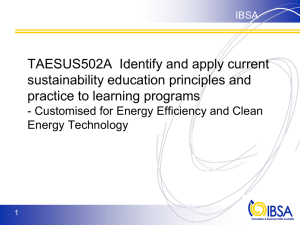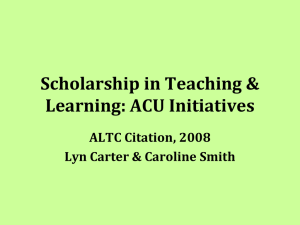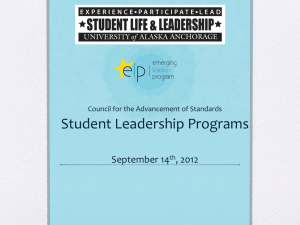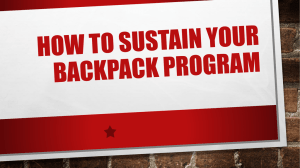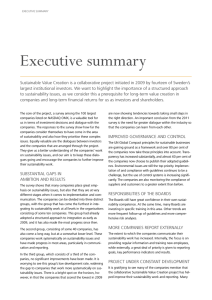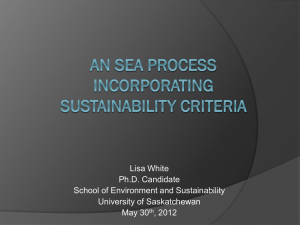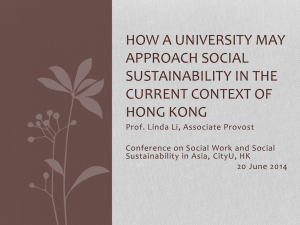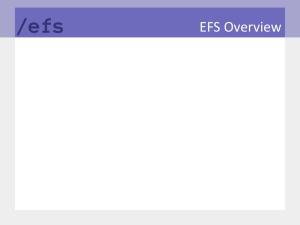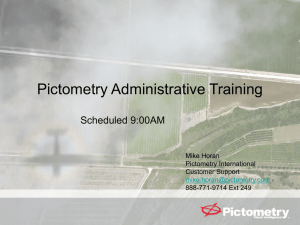TAESUS502A PowerPoint Presentation
advertisement
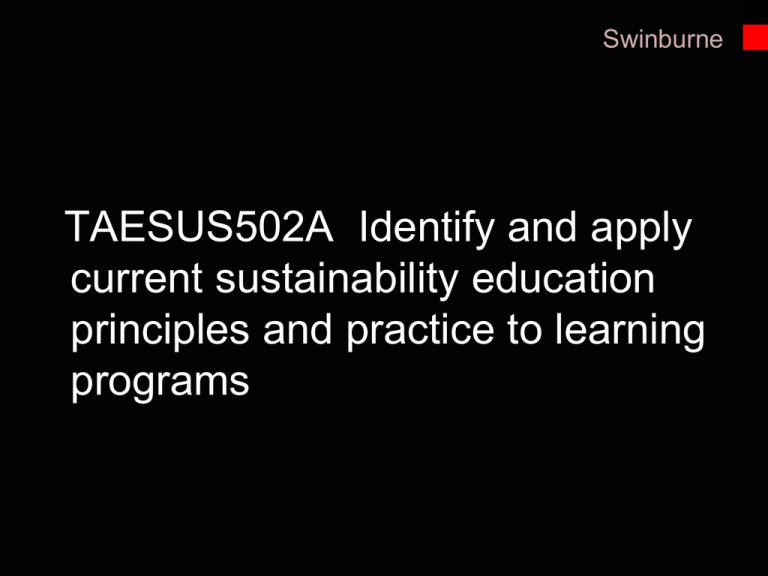
Swinburne TAESUS502A Identify and apply current sustainability education principles and practice to learning programs Swinburne Welcome and Introduction TAESUS502A Identify and apply current sustainability education principles and practice to learning programs Element 1 – Identify effective learning and teaching principles and practice. Element 2 – Research development of current sustainability education principles and practice. Element 3 – Apply current sustainability education principles and practices to learning program. 3 Objectives of two-day workshop At the end of this workshop, you should know how to: > identify and apply principles of effective learning and teaching > describe various definitions of sustainability, cite key historical developments in sustainability education and know where to research significant international and Australian initiatives and policies on EfS > articulate the difference between education about sustainability and education for sustainability and it applies to VET > customise a learning program by applying current sustainability education principles and practice. 4 Introductions > Your name. > Your industry area. > What is your secret to a good life? Swinburne Sustainable Education Principles and Practice The future isn’t what it used to be – how do we prepare our students? ecosystem degradation climate change complexity inequity population pressure overconsumption carbon dioxide species extinction peak oil uncertainty water scarcity resource depletion World Café activity What is sustainability? > There are many definitions of sustainability . > In a group, develop your own definition of sustainability regarding key words, concepts, principles. Appoint a scribe. > The scribe stays with the ideas, other group members move to another scribe. > Rework, fill in gaps from previous group. > Report back to the whole group > Form a definition that the whole group is happy with The important distinction between EaS and EfS Education about sustainability: Education for sustainability: > is an awareness lesson, or theoretical knowledge about sustainability > is the use of education as a tool to achieve a sustainable future > is not necessarily oriented to achieving change. > EfS is focused on empowering people to take action > EfS includes elements of EaS. Historical development of Sustainability Education > Nature Study (19th century) > Environmental Education (EE) > Education for Sustainability (or Education for Sustainable Development – ESD). 10 Swinburne From EE to EfS EfS was originally one of three strands of EE: > education ABOUT the environment – an awareness of environmental concepts (from Science) > education IN the environment – (from Outdoor Education , Geography) > education FOR the environment (EfS) – all the above plus social/economic systems and explicit values and action towards a sustainable future. > The world's first intergovernmental conference (UNESCO/UNEP) on Environmental Education, Tbilisi, Georgia (USSR) October 14-26, 1977 > Agenda 21, called for all countries to develop and implement an ESD strategy by 2002. > UN Decade for Education for Sustainable Development (DESD) 2005–2014. > The Talloires Declaration ten-point action plan for incorporating sustainability and environmental literacy in teaching, research, operations and outreach at colleges and universities. Signed by over 350 institutions in in over 40 countries. 12 ‘There are over 60 million teachers in the world – and each one is a key agent for bringing about the changes in lifestyles and systems that we need [to achieve a sustainable future]’ , UNESCO, 2002. 14 Sustainability skills – Why now? Key initiatives and policies EfS: > Green Skills Agreement (2009) > Living Sustainably: the Australian Government’s National Action Plan for Education for Sustainability (2009) > National VET Sector Sustainability Policy and Action Plan (2009–2012) Swinburne What Makes Learning and Teaching Effective? Activity – What constitutes effective learning? In pairs/a group – brainstorm the following questions and record: > Drawing from your own VET practice or other teaching experience, what do you do well as a teacher/facilitator? > How do you know good learning is taking place? > What are some characteristics of engaged learning? > What are some characteristics of student disengagement with learning? Activity – The importance of prior knowledge … > By yourself, draw a spider. (apologies to arachnophobes ...) > When you have finished, describe your drawing to a partner – number of body parts, number of legs, other appendages. > Compare with a partner. > What do you need to know now? 18 Importance of Prior Knowledge > By asking learners to draw a spider then providing a picture of a real spider, they have actively engaged with learning about the structure of a spider far more deeply than if they were simply shown the same picture at the beginning of the session. > These processes draw from a constructivist approach to teaching and learning. Uncovering prior knowledge Using teaching approaches that uncover and building on prior knowledge provide: > an investment in finding out the answer by setting up ‘the need to know’ > recognition of the range of prior knowledge and the variety of prior knowledge within any group of humans > a state of receptivity and openness where new knowledge can be built on or replace prior knowledge (the ‘teachable moment’). Swinburne How Do Adults Learn? Ways of Learning – VAK > Visual-auditory-kinaesthetic (VAK) is a shorthand version of Multiple Intelligences. > VAK is useful to open up a discussion with a learner about how they learn best. > Conducting a short survey of VAK is useful with any group of learners. Ways of learning – Multiple Intelligences There are many ways of learning and knowing, everyone is capable of using all these each way but each person has their own unique preference pattern and each person has the ability to develop increased capacity in the other areas. – Howard Gardner, Frames of Mind, 1993 The 8 Multiple Intelligences 1. Verbal-linguistic (oral, auditory and written text). 2. Mathematical-logical (numbers, logic, games). 3. Visual-spatial (diagrams, pictures, maps). 4. Body-kinaesthetic (movement). 5. Musical/rhythmic . 6. Social/interpersonal (groups). 7. Intrapersonal (solitary, self-contained). 8. Naturalistic. 1. Verbal-linguistic The student in your class who likes: > reading > writing – often good at spelling > listening > telling stories > speaking to groups. 2. Mathematical-logical A preference for : > mathematical/science subjects > good at patterns and order > numbers > logical, likes to reason > organisation of facts > likes to play games like chess. 3. Visual-spatial A preference for images: > drawing, pictures, movies, puzzles > art, charts, diagrams, maps, concept maps > often the daydreamer. can see things from different perspectives, helicopter and 3D. 4. Body-kinaesthetic A preference for : > things that are ‘hands-on’ > movement > sport, drama, role-plays > good at tool use > touching and feeling > often the student who can’t sit still. 5. Musical/rhythmic A preference for: > music, singing, instrument playing > rhythms, beats > the DJ > often the student who taps on the desk. 6. Social/interpersonal A preference for: > being and working with others > group discussion, debates, team work, cooperative learning, collaboration, problem solving in a group > likes harmony > can be manipulative > empathetic (cries while watching movies!) > often popular, with many friends. 7. Intrapersonal A preference for : > working independently > prefers to be left alone and to do things in their own way > self-directed, self -confident > writing personal journals, > problem solving alone > reflective and has self-knowledge; is metacognitive. 8. Naturalistic A preference for: > nature and being outdoors > working with plants and animals > gardening, growing things > walking in nature, collecting shells > often knows all about insects, snakes, birds, etc. • What are your key Multiple intelligences? Activity: Your MI Profile Birmingham Test Group profile – Your Top 3 Birmingham Test The Implications of the MIs Reflect on your preferred Multiple Intelligences and the way you like to teach: > Which MIs are focused on in most education situations? > What are the risks to your students of delivering learning and assessment using only one or two approaches? > What is the importance of designing a range of learning and assessment approaches for your students? Swinburne What we call ‘best practice’ in teaching and learning comes a number of key educational theorists who have researched different aspects of learning. Swinburne What Do the Learning Theorists Say? The art and science of teaching and learning > Pedagogy – children (school age) > Andragogy – adults (tertiary). Some (of many) Educational Theorists Name Theory Jean Piaget Constructivism Lev Vygotsky Social constructivism David Kolb Experiential learning Howard Gardner Multiple Intelligences Benjamin Bloom Cognitive thinking taxonomy John Brookfield, Malcolm Knowles Adult learning principles Jack Mezirow Transformative learning What do we know about effective learning and teaching? > Learners are not a ‘blank slate on which the teacher writes’. They bring knowledge, skills and experiences that influence how new ideas are received and interpreted, and how skills are learned (called ‘prior knowledge’). > New learning builds on prior knowledge. > Prior knowledge depends on learners’ backgrounds - gender, culture, age, biases, motivations, experiences, educational background, socio-economic status and interests. > Prior knowledge is of particular importance for EfS, and also strongly depends on values, attitudes, worldviews and beliefs. Education in the 21st century … Life-long, requiring: > high level of creativity > critical thinking > decision-making skills > adaptability and flexibility > effective information retrieval and evaluation > holistic/systemic learning, i.e. seeing the connections > education for a sustainable future. http://www.youtube.com/watch?v=zDZFcDGpL4U 11mins Worldviews, values, and beliefs in education > Values are intrinsically important or valuable to us in our lives. > Values do not operate alone, but in combination with our attitudes and beliefs that collectively predispose how we think and behave in different situations. > We are not born with our values, attitudes and beliefs but acquire them during our lives. They can change throughout life. Activity - What are your values? Values activity > What do you value most highly in your life? > Think briefly about what is most important to you in your life. Use the values prompt list to write down single words to represent what you believe to be your key values. > You will, of course, be given the choice about whether to keep this list private or share with others. Discussion – Values and worldviews in VET > What values does your industry or organisation hold? > How do the industry or organisation values relate to your personal values? > How do the industry or organisation values relate to sustainability? > What are some values in education: – In VET programs? – In VET policy and guidelines? Discussion – Values and worldviews in VET > Let’s explore the links between ‘enabling’ effective learning and teaching and VET institutional policies and programs. > Working in small groups, consider your own RTOs and document and discuss institutional policies and programs that support effective learning and teaching. Swinburne Teaching Effectively to Create the Change we Need Sustainability for VET? Reflectionimplications and discussion > How do we create an enabling environment for transformational learning? > How might we teach differently to create change? Let’s revisit some effective learning tools (Topic 1) > exploring prior knowledge > use of MIs > experiential / participatory learning > exploring values > bloom’s levels > transformational learning. Can you think of any others? Let’s revisit principles of EfS (Topic 2) > Transformation and change > Envisioning a better future > Critical thinking and reflection > Participation > Partnerships for change > Systems thinking > Education for all and lifelong learning Source: Living Sustainably: The Australian Government’s National Action Plan for Education for Sustainability Applying EfS principles and tools: Of the seven EfS principles, three in particular provide a range of useful tools for EfS ‘classrooms’’: > Envisioning a better future > Critical thinking and reflection > Systems Thinking. Swinburne Applying Education for Sustainability in VET Sustainability implications for VET? Discussion: EfS and VET – exploring potential synergies and challenges > What potential synergies and challenges exist for embedding sustainability education principles and practice to existing training, programs and policies in your own organisations? Swinburne Embedding Sustainability Education Principles and Practice into Learning Programs Applying effective learning and teaching and sustainability education principles to redesigning a unit of competency Teaching topic: Exploring prior knowledge Use of MIs Experiential learning Exploring values Bloom’s levels Transformational learning Opportunities to include EaS EfS principles Changes to be made:


